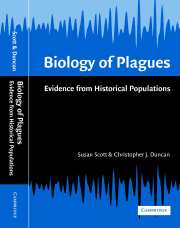Book contents
- Frontmatter
- Contents
- Preface
- Conversion table for imperial to metric units
- 1 Introduction
- 2 Epidemiological concepts
- 3 The biology of bubonic plague
- 4 The Great Pestilence
- 5 Case study: the plague at Penrith in 1597–98
- 6 Pestilence and plague in the 16th century in England
- 7 Plagues in the 16th century in northern England: a metapopulation study
- 8 Plagues in London in the 17th century
- 9 Plagues in the provinces in the 17th century
- 10 Plague at Eyam in 1665–66: a case study
- 11 Continental Europe during the third age of plagues: a study of large-scale metapopulation dynamics
- 12 The plague at Marseilles, 1720–22: an outbreak of bubonic plague?
- 13 Conclusions
- References
- Index
4 - The Great Pestilence
Published online by Cambridge University Press: 28 October 2009
- Frontmatter
- Contents
- Preface
- Conversion table for imperial to metric units
- 1 Introduction
- 2 Epidemiological concepts
- 3 The biology of bubonic plague
- 4 The Great Pestilence
- 5 Case study: the plague at Penrith in 1597–98
- 6 Pestilence and plague in the 16th century in England
- 7 Plagues in the 16th century in northern England: a metapopulation study
- 8 Plagues in London in the 17th century
- 9 Plagues in the provinces in the 17th century
- 10 Plague at Eyam in 1665–66: a case study
- 11 Continental Europe during the third age of plagues: a study of large-scale metapopulation dynamics
- 12 The plague at Marseilles, 1720–22: an outbreak of bubonic plague?
- 13 Conclusions
- References
- Index
Summary
The pandemic that struck Europe in 1347 was probably the most serious outbreak of a lethal infectious disease in history in terms of the percentage of the population that died and the speed with which it spread. This outburst involved the whole of continental Europe, the Channel Islands, the British Isles, Iceland and Greenland (Shrewsbury, 1970; Kohn, 1995).
This pandemic was called the Great Mortality or the Great Pestilence by contemporary writers. It was named the Black Death in English historical writings in 1823 and was introduced into medical literature as such in 1833 because of the black blotches, caused by subcutaneous haemorrhages, that appeared on the skin of the diseased humans near the time of death (Kohn, 1995). Shrewsbury (1970) stated that the latter name was inappropriate because, although the cadaver of a victim of the plague may exhibit a purplish discoloration, the corpse did not turn black. However, since the pseudonym ‘The Black Death’ is so firmly entrenched in historical writing we shall continue to use it.
Although contemporaneous written records are scattered and scarce, the Black Death has been discussed exhaustively (see Creighton, 1894; Nohl, 1926; Hirshleifer, 1966; Deaux, 1969; Ziegler, 1969; Shrewsbury, 1970; Gottfried, 1983; Twigg, 1984; Carmichael, 1986, 1997; Horrox, 1994; Kohn, 1995; Ormrod & Lindley, 1996), covering, in particular its origins, the pattern of spread, the number of deaths from the disease and the role of the rat as a carrier.
- Type
- Chapter
- Information
- Biology of PlaguesEvidence from Historical Populations, pp. 81 - 114Publisher: Cambridge University PressPrint publication year: 2001
- 1
- Cited by



